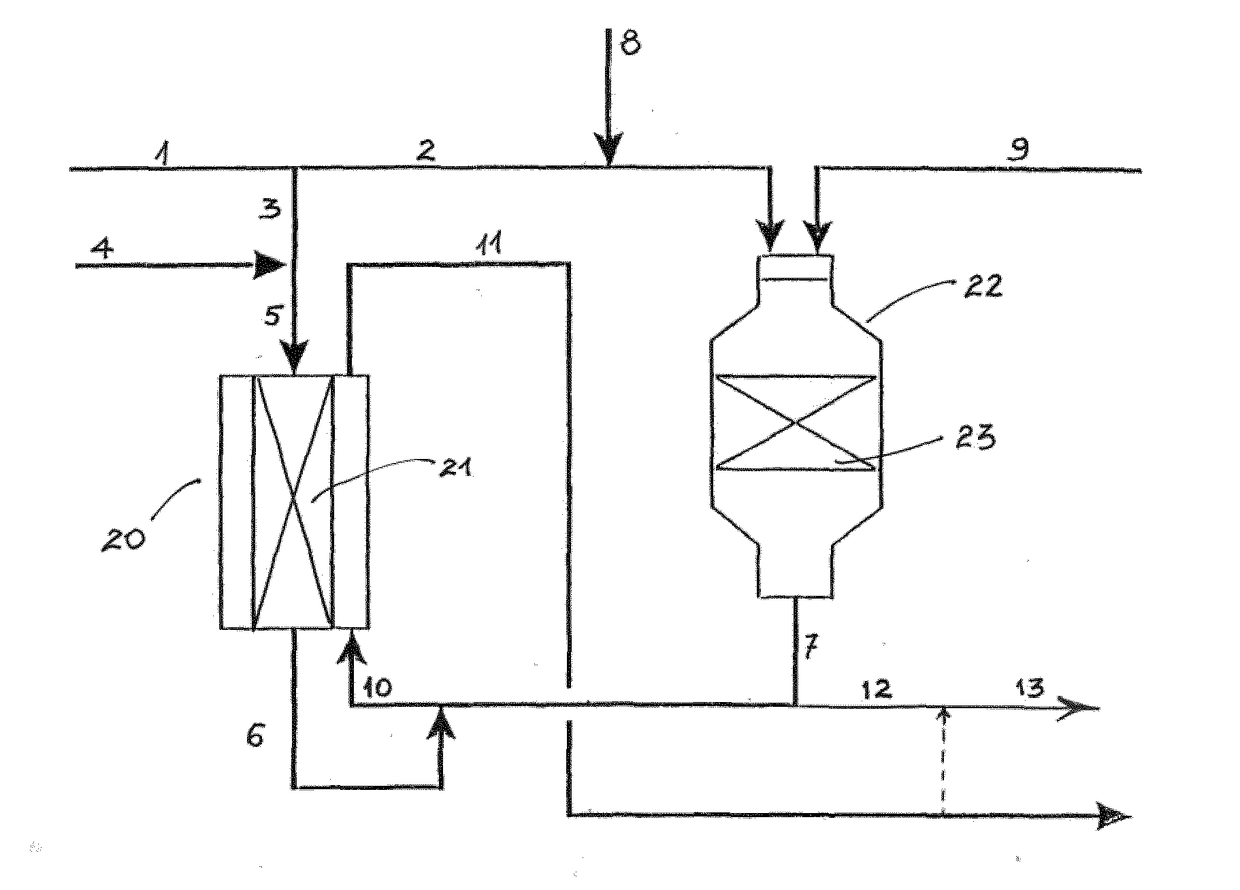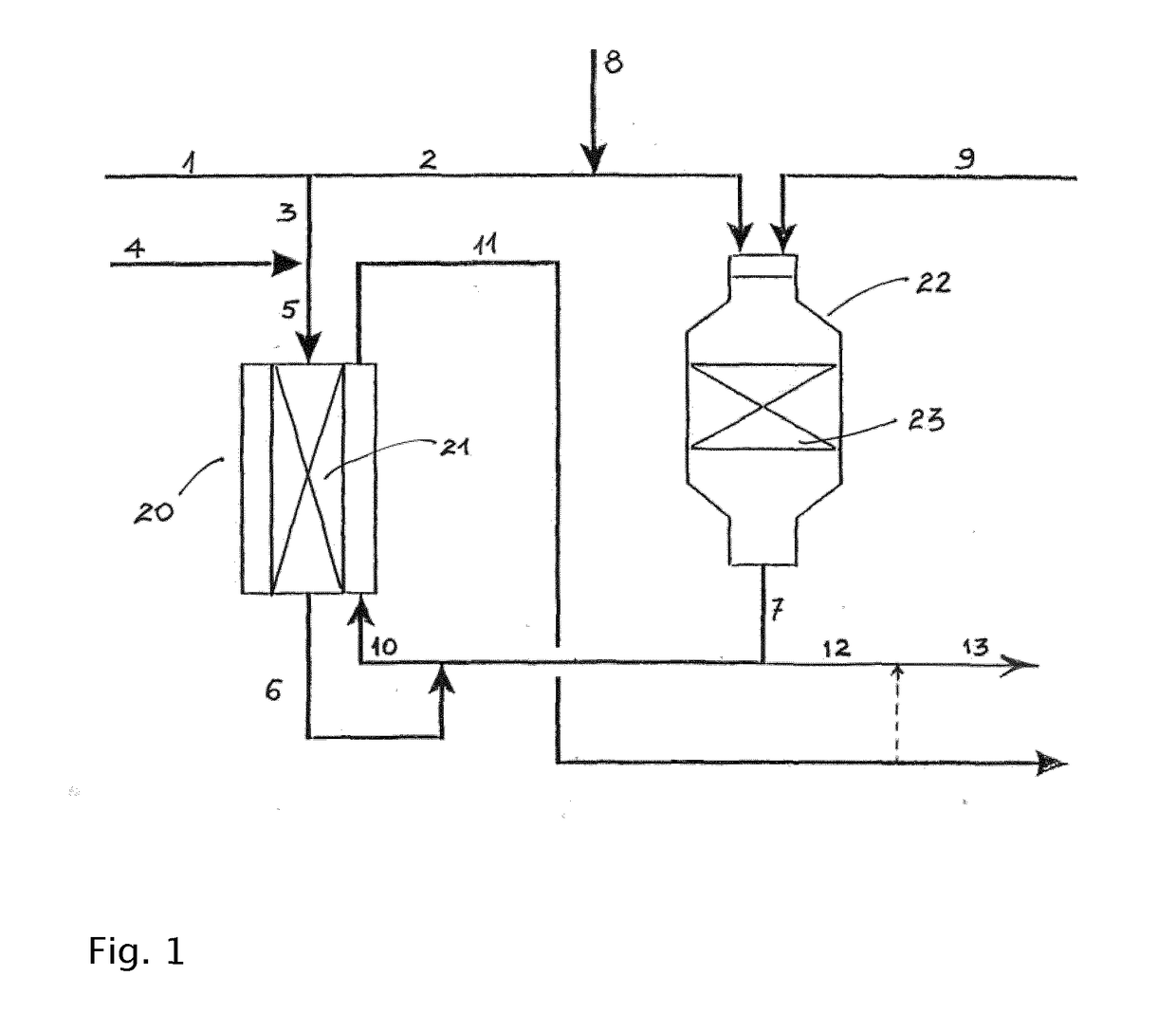Process for producing synthesis gas
a technology of synthesis gas and process, which is applied in the direction of hydrogen/synthetic gas production, chemistry apparatus and processes, inorganic chemistry, etc., can solve the problems of increasing the required heat transfer area of the heat exchange reformer, the combination is counterintuitive, and the apparatus cost is increased, so as to reduce the cost of equipment and reduce the capital cost. , the effect of reducing the cost of equipmen
- Summary
- Abstract
- Description
- Claims
- Application Information
AI Technical Summary
Benefits of technology
Problems solved by technology
Method used
Image
Examples
example 1
[0055]Calculations have been made to simulate the synthesis gas section of a Gas-to-Liquids facility according to the invention as described herein and with reference to the accompanying figure. Natural gas (NG) mixed with steam is used as feed (stream 1). 10% of the feed is sent to the heat exchange reformer (line 3). Additional steam is added to give a steam-to-carbon ratio of the heat exchange reformer feed of 3.5. The remaining part of the feed is mixed with tail gas (line 8) from a Fischer-Tropsch synthesis section for production of liquid hydrocarbons and passed to the ATR. The amount of steam in the feed (line 1) is adjusted such that the S / C-ratio in the feed to the ATR is 0.6. The amount of tail gas added in line 8 is adjusted to provide an H2 / CO-ratio downstream the ATR (line 7) of 2.00. Oxygen is also added to the ATR through line 9. The process conditions are designed to provide an exit temperature of 1025° C. from the ATR.
[0056]Part of the exit stream (line 7), i.e. raw...
example 2
[0060]Calculations have been made to simulate the synthesis gas section of a methanol plant according to the invention as described herein and with reference to the accompanying figure. The parameters have been set to the same values as in Example 1 with the exception that the S / C-ratio in the feed to the ATR is 0.4. The only other difference from the parameters given in Example 1 is that no tail gas is added, i.e. volumetric flow in stream 8 is zero.
[0061]In methanol it is desired to have a so-called module of ca. 2. The module is defined as:
[0062](FH2−FCO2) / (FCO+FCO2), where FX is the flow of component X.
[0063]The results of the calculations are shown in the table below. It is seen that the thermodynamic potential of metal dusting decreases when the bypass ratio is increased.
CO reductionQa2)Bypass ratio1) %bar00.0444200.0485600.0674700.07901)% of ATR effluent gas bypassing heat exchange reactor: stream 12 / stream 72)Qa = PH2O / (PCO * PH2) for the CO reduction CO + H2 = C + H2O, reac...
PUM
| Property | Measurement | Unit |
|---|---|---|
| molar ratio | aaaaa | aaaaa |
| molar ratio | aaaaa | aaaaa |
| molar ratio | aaaaa | aaaaa |
Abstract
Description
Claims
Application Information
 Login to View More
Login to View More - R&D
- Intellectual Property
- Life Sciences
- Materials
- Tech Scout
- Unparalleled Data Quality
- Higher Quality Content
- 60% Fewer Hallucinations
Browse by: Latest US Patents, China's latest patents, Technical Efficacy Thesaurus, Application Domain, Technology Topic, Popular Technical Reports.
© 2025 PatSnap. All rights reserved.Legal|Privacy policy|Modern Slavery Act Transparency Statement|Sitemap|About US| Contact US: help@patsnap.com



